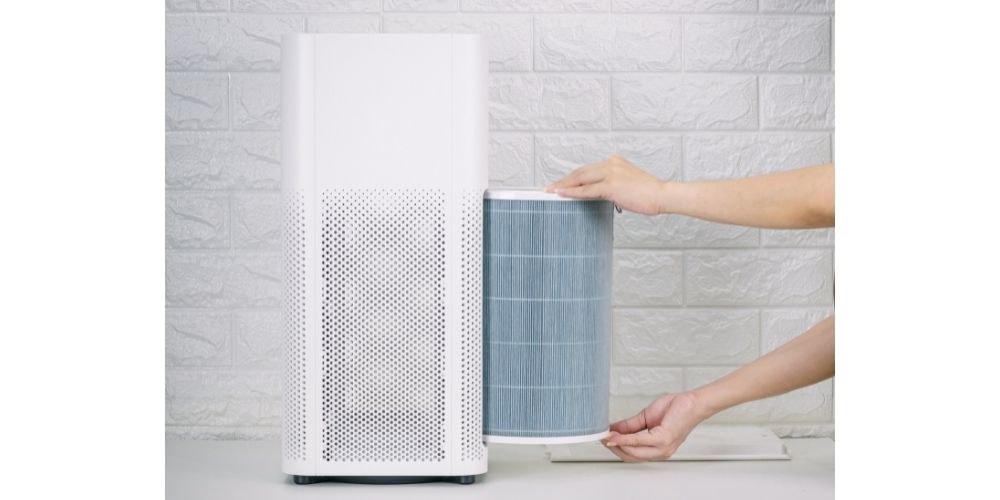How often to change air purifier filter?
Air purifiers are a boon to those of us seeking healthy and clean air in our homes. It is especially helpful to those suffering from asthma and allergies as the air purifier filters help trap contaminants such as pollen, dust, dust mites, pet dander, and other particulates present in the air.
Since the filter is a primary component in the air purifier, it must be cleaned or changed regularly so that the unit remains efficient.
After all, it is the filter that collects all the contaminants over time. To keep the air purifier running efficiently, you must know when to change the filter.
Know when to change your air purifier filter [Check for these signs]

Before you look for signs that the filter in your unit needs to be changed, it is better to know the type and capacity of the filter. Newer models of air purifiers come with a filter change indicator that tells you when the filter has become saturated with pollutants and needs cleaning or changing. But, there are some signs that are noticeable.
1. The filter is dirty
When you notice that the filter looks dirty and gray, it is time to remove it from the unit and clean it. You can also do this proactively by checking the filter once a month.
2. Rooms are dusty
When the air filters become saturated with air contaminants, your home will become dustier. The filter has no more room for catching dust, and it starts to accumulate around the air vents at first and then spreads throughout the house.
3. Allergy symptoms
As the filter becomes clogged with dust, you or your family members may develop symptoms caused by allergens in the air. Usually, these symptoms are red eyes, runny nose, sore throat, etc.
4. Musty odor
You will notice that the air indoors carries a musty odor caused by mold or mold spores. There could also be a burning smell coming from your HVAC unit if your air filter is dirty or clogged.
5. Hot AC unit
When the air filter is blocked, the HVAC unit works harder to ease the airflow through the filter. You will notice that the AC unit is becoming hot to the touch. Another sign that the HVAC is working harder is when you see a spike in the energy bill.
Learn how to Change an Air Filter
Air purifiers do their best work if they are maintained well. Proper maintenance also increases the lifespan of the unit even as it consumes less energy, leading to lower energy bills. So, it is helpful to learn how to change the air filter.
➡ Start by switching the air purifier off. By switching it off, we ensure that the air does not blow dust into the unit.
➡ The next step is to open the vent and remove the filter.
➡ Make sure that the airflow arrows are pointed towards the direction of the HVAC system.
➡ Replace with a new filter.
➡ Switch the air purifier on.
Before buying a new filter, you need to check the owner’s manual. It will offer instructions on the right one for the particular model you have installed.
How can you improve the performance of air purifier?
Considering the benefits of an air purifier, you must ensure that the unit is performing optimally. A few steps to improve its performance, include:
Close windows and doors
If the windows and doors are open, the already purified air will leave the room, and polluted air from outside will seep into the room.
Replace or clean the air filters at the right time
Air filters can get clogged over time, and the dust particles will accumulate on the filter, blocking airflow. Therefore, it is best to proactively clean the filter.
Place air purifiers in the right location
Air purifiers need space around them for smooth airflow. If the unit is placed in such a way that there are obstructions such as walls or furniture, the unit will not be able to draw in the air or recirculate clean air into the room freely.
Washable filter vs. disposable: Which is better for you?

Understanding the difference between the two will help you decide between a washable and a disposable filter.
While washable filters are good, they are better at trapping dirt and large particles. They are not very effective in filtering out pet dander, viruses, bacteria, or smoke. A washable filter has several layers of fibers and is held together by a frame. Dust can accumulate on the frame, too.
Washable filters will need to be washed thoroughly, dried completely to avoid mold, and returned to the unit.
On the other hand, a disposable filter can trap fine particles and as much as 95% of the airborne contaminants. Disposable filters are generally more effective as they trap smaller particles. They are cheaper than washable, reusable filters.
The MERV ratings of disposable filters also make them energy-efficient.
Whichever filter you choose, the critical factor is cleaning or replacing at the right time to ensure that the air purifier works efficiently.
FAQ Section
1. Can you wash air purifier filters?
You can wash your air purifier filters with warm water and allow them to dry completely before placing them back in the system. You will need to make sure that you are using washable filters and not disposable ones.
2. Do all filters need to be replaced?
All filters will need to be replaced when it is the right time. You will know the right time when you notice that your air purifier is not working well and the indoor air is gradually becoming unclean. Washable filters can be washed and returned to the unit. Disposable filters need to be replaced every few months, according to the owner’s manual.
Eventually, even washable filters will need to be replaced due to wear and tear.
3. How often should you clean an air purifier?
Generally, air purifiers must be cleaned according to a scheduled filter maintenance plan. It would include replacing the filters every year. If the air purifier has carbon filters, they must be replaced anywhere between three and six months. Permanent or washable filters must be cleaned every three months.
4. How long do HEPA filters last?
True HEPA filters have approximately 8,760 hours or 12 months of use before they need to be cleaned or replaced. However, it may also depend on the quality of the filter, the air quality, and the region you live in.
5. Can you use an air purifier without a filter?
Earlier models of air purifiers depended on filters. However, the new air purifiers work with advanced cleaning technology instead of filters. They use specific cleaning technology to purify the air.
6. How many types of HEPA filters are there?
As per the Institute of Environmental Science and Technology (IEST), there are six types of HEPA filters – A, B, C, D, E, and F. Each has its own distinct characteristics based on performance. Their minimum efficiency reporting value is between 99.97 and 99.99% at 0.3 microns, with the F type at 0.1 – 0.2 microns.
Wrapping Up
Air purifiers play a significant role in our lives by keeping the indoor air clean and healthy. However, they will only serve their purpose if the filter is clean.
Therefore, it is up to us to ensure that the filters are either cleaned or replaced proactively, to enjoy healthy air quality.

About The Author
Olivia — a self-confessed air quality addict — is a home climate enthusiast, fresh air advocate, and someone with deep personal experience and knowledge about mold extermination. Her work was mentioned in countless notable humidity publications. Previously she was an editor at Mold Remediation.